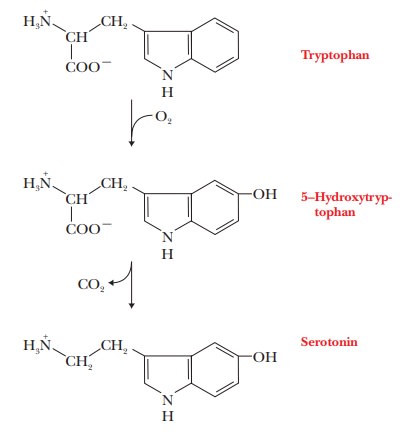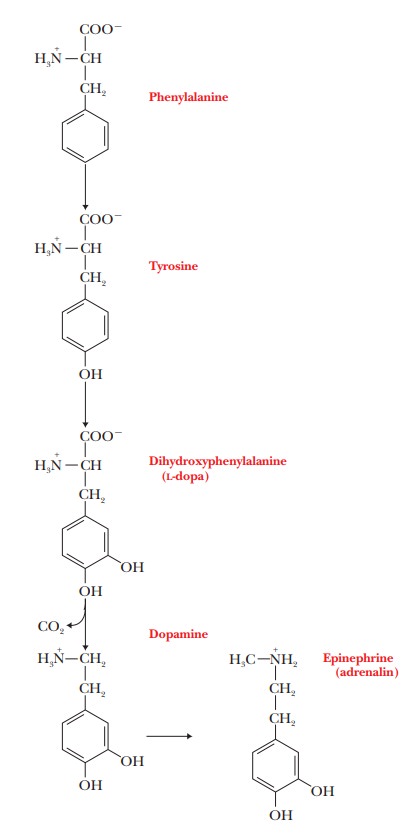Chapter: Biochemistry: Amino Acids and Peptides
Amino Acids to Calm Down and Pep Up
Amino Acids to Calm Down and Pep
Up
Two
amino acids deserve some special notice because both are key precursors to many
hormones and neurotransmitters (substances involved in the transmission of
nerve impulses). The study of neurotransmitters is work in progress, but we do
recognize that certain key molecules appear to be involved. Because many
neurotransmitters have very short biological half-lives and function at very
low concentrations, we also recognize that other derivatives of these molecules
may be the actual biologically active forms.
Two of
the neurotransmitter classes are simple derivatives of the two amino acids tyrosine and tryptophan. The active products are monoamine derivatives, which
are themselves degraded or deactivated by monoamine oxidases (MAOs).
Tryptophan
is converted to serotonin, more properly called 5-hydroxytryptamine.

Tyrosine,
itself normally derived from phenylalanine, is con-verted to the class called
catecholamines, which includes epineph-rine, commonly known by its proprietary
name, adrenalin.
Note
that L-dihydroxyphenylalanine (L-dopa) is an intermediate in the conversion of
tyrosine. Lower-than-normal levels of L-dopa are involved in Parkinson’s disease.
Tyrosine or phenylalanine supple-ments might increase the levels of dopamine,
though L-dopa, the immediate precursor, is usually prescribed because L-dopa
passes into the brain quickly through the blood–brain barrier.
Tyrosine
and phenylalanine are precursors to norepinephrine and epinephrine, both of
which are stimulatory. Epinephrine is commonly known as the “flight or fight”
hormone. It causes the release of glucose and other nutrients into the blood
and also stimulates brain function. People taking MAO inhibitors stay in a
relatively high mental state, sometimes too high, because the epinephrine is
not metabolized rapidly. Tryptophan is a precursor to serotonin, which has a
sedative effect, giving a pleasant feel-ing. Very low levels of serotonin are
associated with depression, while extremely high levels actually produce a
manic state. Manic-depressive illness (also called bipolar disorder) can be
managed by controlling the levels of serotonin and its further metabolites.
It has
been suggested that tyrosine and phenylalanine may have unexpected effects in
some people. For example, there is increas-ing evidence that some people get
headaches from the phenylala

It is also likely that many illegal
psychedelic drugs, such as mescaline and psilocine, mimic and interfere with
the effects of neurotrans-mitters. A recent Oscar-winning film, A Beautiful Mind, focused on the
disturbing problems associated with schizophrenia. Until recently, the
neurotransmitter dopamine was a major focus in the study of schizophrenia. More
recently, it has been suggested that irregularities in the metabolism of
glutamate, a neurotransmitter, can lead to the disease.
Some
people insist that supplements of tyrosine give them a morning lift and that
tryptophan helps them sleep at night. Milk proteins have high levels of
tryptophan; a glass of warm milk before bed is widely believed to be an aid in
inducing sleep. Cheese and red wines contain high amounts of tyramine, which mimics
epinephrine; for many people a cheese omelet in the morning is a favorite way
to start the day.
Related Topics